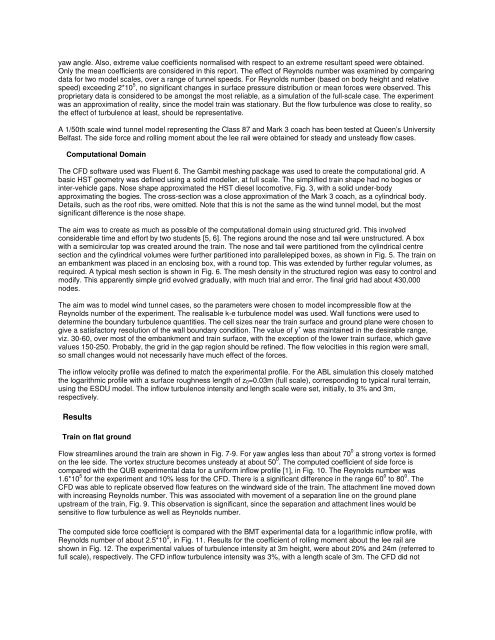Integrating CFD and Experiment in Aerodynamics - CFD4Aircraft
Integrating CFD and Experiment in Aerodynamics - CFD4Aircraft
Integrating CFD and Experiment in Aerodynamics - CFD4Aircraft
Create successful ePaper yourself
Turn your PDF publications into a flip-book with our unique Google optimized e-Paper software.
yaw angle. Also, extreme value coefficients normalised with respect to an extreme resultant speed were obta<strong>in</strong>ed.<br />
Only the mean coefficients are considered <strong>in</strong> this report. The effect of Reynolds number was exam<strong>in</strong>ed by compar<strong>in</strong>g<br />
data for two model scales, over a range of tunnel speeds. For Reynolds number (based on body height <strong>and</strong> relative<br />
speed) exceed<strong>in</strong>g 2*10 5 , no significant changes <strong>in</strong> surface pressure distribution or mean forces were observed. This<br />
proprietary data is considered to be amongst the most reliable, as a simulation of the full-scale case. The experiment<br />
was an approximation of reality, s<strong>in</strong>ce the model tra<strong>in</strong> was stationary. But the flow turbulence was close to reality, so<br />
the effect of turbulence at least, should be representative.<br />
A 1/50th scale w<strong>in</strong>d tunnel model represent<strong>in</strong>g the Class 87 <strong>and</strong> Mark 3 coach has been tested at Queen’s University<br />
Belfast. The side force <strong>and</strong> roll<strong>in</strong>g moment about the lee rail were obta<strong>in</strong>ed for steady <strong>and</strong> unsteady flow cases.<br />
Computational Doma<strong>in</strong><br />
The <strong>CFD</strong> software used was Fluent 6. The Gambit mesh<strong>in</strong>g package was used to create the computational grid. A<br />
basic HST geometry was def<strong>in</strong>ed us<strong>in</strong>g a solid modeller, at full scale. The simplified tra<strong>in</strong> shape had no bogies or<br />
<strong>in</strong>ter-vehicle gaps. Nose shape approximated the HST diesel locomotive, Fig. 3, with a solid under-body<br />
approximat<strong>in</strong>g the bogies. The cross-section was a close approximation of the Mark 3 coach, as a cyl<strong>in</strong>drical body.<br />
Details, such as the roof ribs, were omitted. Note that this is not the same as the w<strong>in</strong>d tunnel model, but the most<br />
significant difference is the nose shape.<br />
The aim was to create as much as possible of the computational doma<strong>in</strong> us<strong>in</strong>g structured grid. This <strong>in</strong>volved<br />
considerable time <strong>and</strong> effort by two students [5, 6]. The regions around the nose <strong>and</strong> tail were unstructured. A box<br />
with a semicircular top was created around the tra<strong>in</strong>. The nose <strong>and</strong> tail were partitioned from the cyl<strong>in</strong>drical centre<br />
section <strong>and</strong> the cyl<strong>in</strong>drical volumes were further partitioned <strong>in</strong>to parallelepiped boxes, as shown <strong>in</strong> Fig. 5. The tra<strong>in</strong> on<br />
an embankment was placed <strong>in</strong> an enclos<strong>in</strong>g box, with a round top. This was extended by further regular volumes, as<br />
required. A typical mesh section is shown <strong>in</strong> Fig. 6. The mesh density <strong>in</strong> the structured region was easy to control <strong>and</strong><br />
modify. This apparently simple grid evolved gradually, with much trial <strong>and</strong> error. The f<strong>in</strong>al grid had about 430,000<br />
nodes.<br />
The aim was to model w<strong>in</strong>d tunnel cases, so the parameters were chosen to model <strong>in</strong>compressible flow at the<br />
Reynolds number of the experiment. The realisable k-e turbulence model was used. Wall functions were used to<br />
determ<strong>in</strong>e the boundary turbulence quantities. The cell sizes near the tra<strong>in</strong> surface <strong>and</strong> ground plane were chosen to<br />
give a satisfactory resolution of the wall boundary condition. The value of y + was ma<strong>in</strong>ta<strong>in</strong>ed <strong>in</strong> the desirable range,<br />
viz. 30-60, over most of the embankment <strong>and</strong> tra<strong>in</strong> surface, with the exception of the lower tra<strong>in</strong> surface, which gave<br />
values 150-250. Probably, the grid <strong>in</strong> the gap region should be ref<strong>in</strong>ed. The flow velocities <strong>in</strong> this region were small,<br />
so small changes would not necessarily have much effect of the forces.<br />
The <strong>in</strong>flow velocity profile was def<strong>in</strong>ed to match the experimental profile. For the ABL simulation this closely matched<br />
the logarithmic profile with a surface roughness length of z 0=0.03m (full scale), correspond<strong>in</strong>g to typical rural terra<strong>in</strong>,<br />
us<strong>in</strong>g the ESDU model. The <strong>in</strong>flow turbulence <strong>in</strong>tensity <strong>and</strong> length scale were set, <strong>in</strong>itially, to 3% <strong>and</strong> 3m,<br />
respectively.<br />
Results<br />
Tra<strong>in</strong> on flat ground<br />
Flow streaml<strong>in</strong>es around the tra<strong>in</strong> are shown <strong>in</strong> Fig. 7-9. For yaw angles less than about 70 0 a strong vortex is formed<br />
on the lee side. The vortex structure becomes unsteady at about 50 0 . The computed coefficient of side force is<br />
compared with the QUB experimental data for a uniform <strong>in</strong>flow profile [1], <strong>in</strong> Fig. 10. The Reynolds number was<br />
1.6*10 5 for the experiment <strong>and</strong> 10% less for the <strong>CFD</strong>. There is a significant difference <strong>in</strong> the range 60 0 to 80 0 . The<br />
<strong>CFD</strong> was able to replicate observed flow features on the w<strong>in</strong>dward side of the tra<strong>in</strong>. The attachment l<strong>in</strong>e moved down<br />
with <strong>in</strong>creas<strong>in</strong>g Reynolds number. This was associated with movement of a separation l<strong>in</strong>e on the ground plane<br />
upstream of the tra<strong>in</strong>, Fig. 9. This observation is significant, s<strong>in</strong>ce the separation <strong>and</strong> attachment l<strong>in</strong>es would be<br />
sensitive to flow turbulence as well as Reynolds number.<br />
The computed side force coefficient is compared with the BMT experimental data for a logarithmic <strong>in</strong>flow profile, with<br />
Reynolds number of about 2.5*10 5 , <strong>in</strong> Fig. 11. Results for the coefficient of roll<strong>in</strong>g moment about the lee rail are<br />
shown <strong>in</strong> Fig. 12. The experimental values of turbulence <strong>in</strong>tensity at 3m height, were about 20% <strong>and</strong> 24m (referred to<br />
full scale), respectively. The <strong>CFD</strong> <strong>in</strong>flow turbulence <strong>in</strong>tensity was 3%, with a length scale of 3m. The <strong>CFD</strong> did not
















